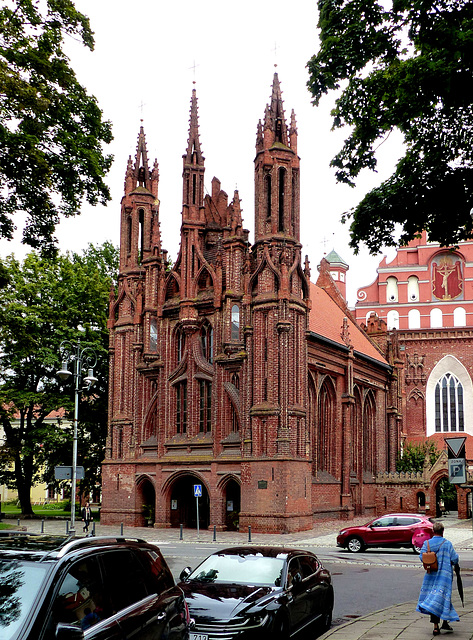Vilnius - Šv. Onos bažnyčia
Vilnius - Šv. Onos bažnyčia
Vilnius - Šv. Onos bažnyčia
Vilnius - Šv. Pranciškaus Asyžiečio bažnyčia
Vilnius - Šv. Pranciškaus Asyžiečio bažnyčia
Vilnius - Šv. kankinės Paraskevės cerkvė
Vilnius - Valdnieku pils
Vilnius - Vilniaus mažasis teatras
Vilnius
Vilnius
Vilnius - Šv. Stanislovo ir Šv. Vladislovo arkikat…
Vilnius - Šv. Stanislovo ir Šv. Vladislovo arkikat…
Vilnius - Šv. Stanislovo ir Šv. Vladislovo arkikat…
Vilnius - Šv. Stanislovo ir Šv. Vladislovo arkikat…
Vilnius - Holocaust
Vilnius - Holocaust
Vilnius - Dievo Motinos Ėmimo į Dangų soboras
Vilnius - Dievo Motinos Ėmimo į Dangų soboras
Vilnius - Astronomical Observatory
Vilnius - Šv. Jono Krikštytojo ir Šv. Jono apaštal…
Vilnius - Georg Forster
Vilnius - Art Nouveau
Vilnius - Šv. Mikalojaus Stebukladario palaikų Per…
Vilnius - Ģedimina tornis
Vilnius - Ģedimina tornis
Vilnius - Universitāte
Bauska - Svētā Gara baznīcu
Krimuldas baznīca
Krimuldas baznīca
Krimuldas baznīca
Strasbourg - Saint-Thomas
Strasbourg - Saint-Thomas
Sigulda
Fidenza - Cattedrale di San Donnino
Cēsis - Pils
Cēsis - Svētā Jāņa baznīca
Cēsis - Svētā Jāņa baznīca
Cēsis - Svētā Jāņa baznīca
Cēsis - Svētā Jāņa baznīca
Cēsis - Svētā Jāņa baznīca
Cēsis - Svētā Jāņa baznīca
Cēsis - Svētā Jāņa baznīca
Cēsis
Alūksne - Jaunā pils
Alūksne - Lake Alūksne
Location
Lat, Lng:
You can copy the above to your favourite mapping app.
Address: unknown
You can copy the above to your favourite mapping app.
Address: unknown
See also...
Keywords
Authorizations, license
-
Visible by: Everyone -
All rights reserved
-
95 visits
Vilnius - Šv. Onos bažnyčia


Vilnius is the capital and largest city of Lithuania, with a population of about 600.000. Before WWII, Vilnius was one of the largest Jewish centers in Europe which led to the nickname "the Jerusalem of Lithuania".
The city was first mentioned in written sources as Vilna in 1323 as the capital city of the Grand Duchy of Lithuania. Gediminas, Grand Duke of Lithuania, built a wooden castle on a hill in the city. The city became more widely known after he wrote a circular letter of invitation to Germans and Jews to the principal Hansa towns in 1325, offering free access into his domains to men of every order and profession. At this time Vilnius was facing raids of the Teutonic Order, although they never captured the castle, large portions of the town were burned down between 1365 and 1383. English king Henry IV spent the full year of 1390 supporting the unsuccessful siege of Vilnius by Teutonic Knights with his 300 fellow knights.
Between 1503 and 1522, the city was surrounded by a city wall to protect it from Crimean Tatar attacks. The city reached the peak of its development during the reign of Sigismund II. Augustus, Grand Duke of Lithuania and King of Poland, settled here in 1544. After the foundation of the Polish-Lithuanian Commonwealth in 1569, the city experienced a further boom, as Stephen Báthory, King of Poland and Grand Duke of Lithuania, founded the Jesuit College of Vilnius (= Vilnius University) in 1579.
The first (wooden) church at this site was built for Anna, Grand Duchess of Lithuania, the first wife of Vytautas the Great. It burned down in 1419. The present church was constructed on the initiative of the King of Poland and Grand Duke of Lithuania Alexander I Jagiellon. The exterior of the church has remained almost unchanged since then. The church was renovated in the 1900s when the walls were strengthened with iron. During the Soviet Era, the church remained open and was even renovated between 1960–1970 when the towers were in bad shape.
Translate into English
The city was first mentioned in written sources as Vilna in 1323 as the capital city of the Grand Duchy of Lithuania. Gediminas, Grand Duke of Lithuania, built a wooden castle on a hill in the city. The city became more widely known after he wrote a circular letter of invitation to Germans and Jews to the principal Hansa towns in 1325, offering free access into his domains to men of every order and profession. At this time Vilnius was facing raids of the Teutonic Order, although they never captured the castle, large portions of the town were burned down between 1365 and 1383. English king Henry IV spent the full year of 1390 supporting the unsuccessful siege of Vilnius by Teutonic Knights with his 300 fellow knights.
Between 1503 and 1522, the city was surrounded by a city wall to protect it from Crimean Tatar attacks. The city reached the peak of its development during the reign of Sigismund II. Augustus, Grand Duke of Lithuania and King of Poland, settled here in 1544. After the foundation of the Polish-Lithuanian Commonwealth in 1569, the city experienced a further boom, as Stephen Báthory, King of Poland and Grand Duke of Lithuania, founded the Jesuit College of Vilnius (= Vilnius University) in 1579.
The first (wooden) church at this site was built for Anna, Grand Duchess of Lithuania, the first wife of Vytautas the Great. It burned down in 1419. The present church was constructed on the initiative of the King of Poland and Grand Duke of Lithuania Alexander I Jagiellon. The exterior of the church has remained almost unchanged since then. The church was renovated in the 1900s when the walls were strengthened with iron. During the Soviet Era, the church remained open and was even renovated between 1960–1970 when the towers were in bad shape.
Berny has particularly liked this photo
- Keyboard shortcuts:
Jump to top
RSS feed- Latest comments - Subscribe to the comment feeds of this photo
- ipernity © 2007-2025
- Help & Contact
|
Club news
|
About ipernity
|
History |
ipernity Club & Prices |
Guide of good conduct
Donate | Group guidelines | Privacy policy | Terms of use | Statutes | In memoria -
Facebook
Twitter

Sign-in to write a comment.